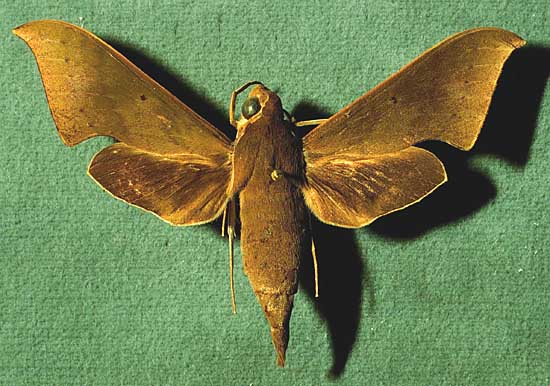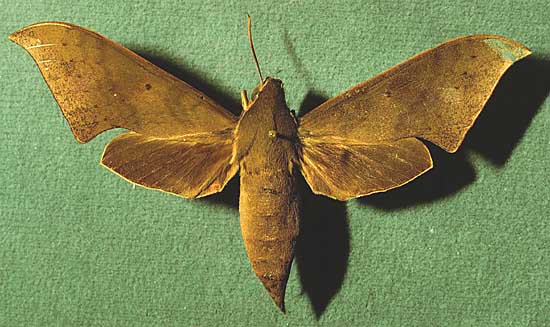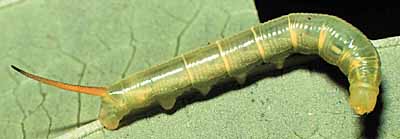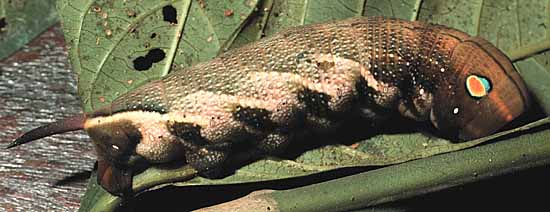Xylophanes hannemanni
Xylophanes hannemanni
zail-AH-fan-eesmm han-neh-MAN-eye
or
zye-LAH-fan-eesmm han-neh-MAN-eye
Closs, 1917

Xylophanes hannemanni male courtesy of Dan Janzen.
This site has been created by
Bill Oehlke at oehlkew@islandtelecom.com
Comments, suggestions and/or additional information are welcomed by Bill.
TAXONOMY:
Family: Sphingidae, Latreille, 1802
Subfamily: Macroglossinae, Harris, 1839
Tribe: Macroglossini, Harris, 1839
Genus: Xylophanes Hubner [1819] ...........
Species: hannemanni Closs, 1917
|
MIDI MUSIC
.....It's a Wonderful World.....
copyright C. Odenkirk
ON.OFF
<bgsound src="world.mid" LOOP=FOREVER>
|
DISTRIBUTION:
Xylophanes hannemanni
(wingspan: 68-83 mm, females larger than males)
flies in the
Atlantic regions of Mexico (specimen type locality) Hidalgo,
Guatemala,
(probably Honduras)
Nicaragua,
Costa Rica and
Panama: Chiriqui, and further south
through
Colombia,
Venezuela: (Barinas (JRAC));
Ecuador,
Peru,
to
Bolivia: Cochabamba: Chapare, Yunga del
Espíritu Santo, La Paz: Murillo, Río Zongo, (750m).
Very similar to Xylophanes germen but outer margin of forewing smooth
(except for some specimens from Peru and Bolivia, in which the outer margin may be slightly crenulate) and somewhat concave. CATE
The pronunciation of scientific names is
troublesome for many. The "suggestions" at the top of the page are
merely suggestions. They are based on commonly
accepted English pronunciation of Greek names and/or some
fairly well accepted "rules" for latinized scientific names.
In some cases I have anglicized the pronunciations as per
more common usage.
The suggested pronunciations, on this page and on other pages,
are primarily put forward to assist those who hear with internal
ears as they read.
There are many collectors from different countries whose
intonations and accents would be different.
Jean Marie Cadiou writes, "When I say "Xylophanes" in English I
pronounce it something like "Zailophanees", with the emphasis on the
"o". The French pronounce it differently, something like
"Kzeelophaness" with no emphasis, and the Germans yet in a
different way..."
In Greek myth, Phanes is the golden winged Primordial Being who
was hatched from the shining Cosmic Egg that was the source of the
universe. He personifies light emerging from chaos.
"Xylo" is the Greek word for wood.
The specimen type for the genus
Xylophanes is Xylophanes anubus. Perhaps ? when Hubner
examined this species, the yellow-orange and brown tones of the
forewings suggested wings of wood.
The species name "hannemanni" is
honorific for Dr. H. J. Hannemann.
FLIGHT TIMES:
Xylophanes hannemanni adults fly probably produce at least three broods
annually. Adults are taken in every month of the year in Costa Rica.
ECLOSION:
Pupae probably wiggle to surface from subterranean chambers just prior to eclosion.

Xylophanes hannemanni female courtesy of Dan Janzen.
SCENTING AND MATING:Females call in the males with a pheromone released from a gland at the tip of the
abdomen. Males come in to lights very readily, but females are seldom taken in that way.
EGGS, LARVAE, PUPAE:
Larvae feed on Psychotria panamensis, Psychotria correae,
Psychotria horizontalis, Psychotria eurycarpa, Psychotria elata
and Psychotria nervosa and Palicourea padifolia and
Coussarea austin-smithii
of the Rubiaceae family and on
Thalia geniculata of the Marantaceae family.
The "eyespots" are barely noticeable in second instar larvae and usually do not become evident
until third or fourth instar. |
 |
Larvae have a very broad tail when seen from the side.
The eyes do not bulge, have blue at the top of the yellow,
pink center, black ring, yellow general, and black on side of tail slash.


Moths emerge approximately twenty-one days to two months after larvae pupate, but some will "overwinter",
emerging in March after pupating in July. |  |
Larvae are subject to parasitization by Thyreodon white
of the Ichneumonidae family and by Drino sp. 3 and Siphona sp. 6
of the Tachinidae family.
Use your browser "Back" button to return to the previous page.
Goto Main Sphingidae Index
Goto Macroglossini Tribe
Goto Central American Indices
Goto Carribean Islands
Goto South American Indices
Goto U.S.A. tables





